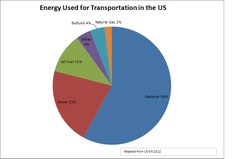
Interest in natural gas fueled vehicles has grown substantially in recent years, as people seek lower cost alternatives to gasoline and diesel. Currently natural gas powers about 112,000 vehicles in the United States and roughly 14.8 million vehicles worldwide.
Benefits of Natural Gas Vehicles
- Lower prices at the pump.
- 20-30 percent fewer Greenhouse Gas Emissions and 95 percent fewer tailpipe emissions versus gasoline.
- Extended engine life.
- Domestically produced energy.
- Similar driving experience as conventional vehicles.
Challenges of Natural Gas Vehicles
- Substantial up-front vehicle costs.
- Limited places to refuel.
- Limited vehicle selection.
- Longer refueling times.
- Shorter driving range versus traditional fuels.
Natural Gas Fuels: What are the Options?
There are several forms of natural gas, as well as propane that can be utilized as transportation fuels:
- CNG (Compressed Natural Gas) is natural gas(CH4) compressed to 3,600 psi and stored on-board as a gas in pressurized tanks. CNG has a relatively low energy density compared to other fuels. It requires approximately 0.51 cubic feet of CNG to equal the btu value of one gallon of gasoline. In other words, a CNG tank with an interior volume of 20 gallons would hold the energy equivalent of 6 gallons of gasoline. So on a practical basis, CNG vehicles will have shorter driving ranges verses conventional vehicles with similar size fuel tanks. CNG vehicles are well suited for high-mileage, centrally-fueled fleets that operate within a limited area. They may also be a good fit for commuter vehicles in conjunction with home refueling units.
- LNG, or Liquified Natural Gas, is natural gas (CH4) chilled to –260 degrees Fahrenheit and stored as a liquid in thermal tanks. One gallon of LNG has 64 percent of the btu value of one gallon of gasoline. LNG is much more energy dense than CNG so LNG is often more suited for vehicles needing to travel longer distances between refueling. Best applications include class 7 and 8 heavy duty vehicles, marine and rail. One of the problems with LNG as a fuel is that as it warms, the fuel needs to be utilized or vented. So LNG should be utilized within a few days of refueling. Therefore LNG is not well suited to vehicles that sit for long periods of time between uses.
- Propane is a hydrocarbon gas (C3H8) often produced in association with natural gas and petroleum. Significant amounts of propane are produced in liquids-rich areas of the Marcellus and Utica shales in western Pennsylvania and eastern Ohio. Propane is stored in a liquid state at 200-300 psi. One of the advantages of propane is that it can be delivered and stored via lower pressure and less costly equipment compared to CNG. It also has a relatively high energy density: one gallon of propane has 73 percent of the btu value of one gallon of gasoline. Propane is best suited for light duty cars and trucks and school busses; although at current market prices it’s not cost-competitive with CNG.
Next week will feature the second part, which is on pricing and effects of market changes.
Author: David T. Messersmith, Extension Educator, Penn State EXTENSION.


